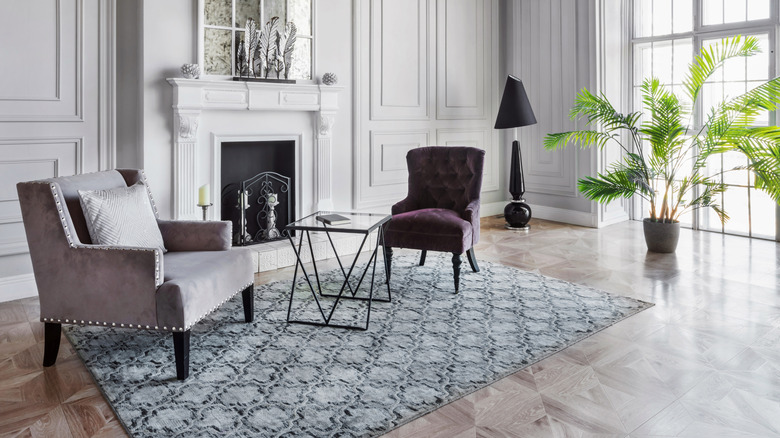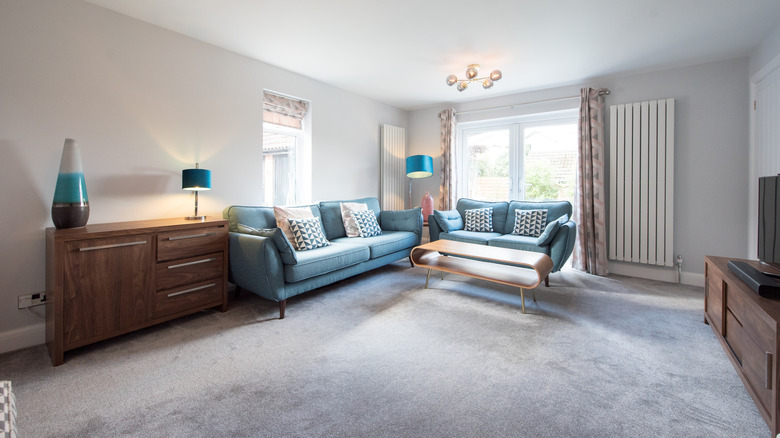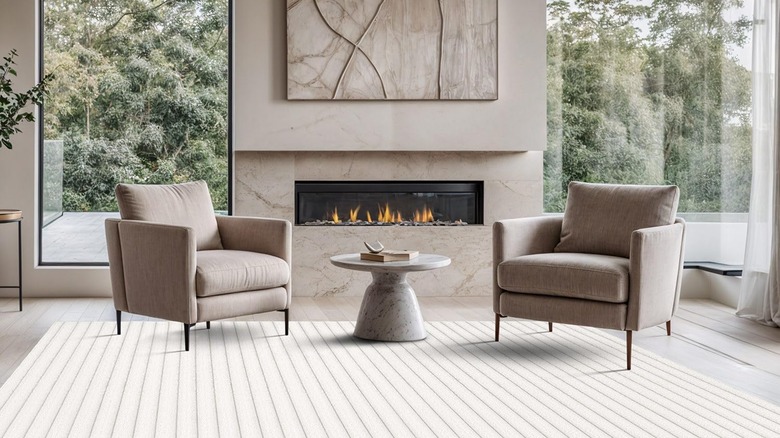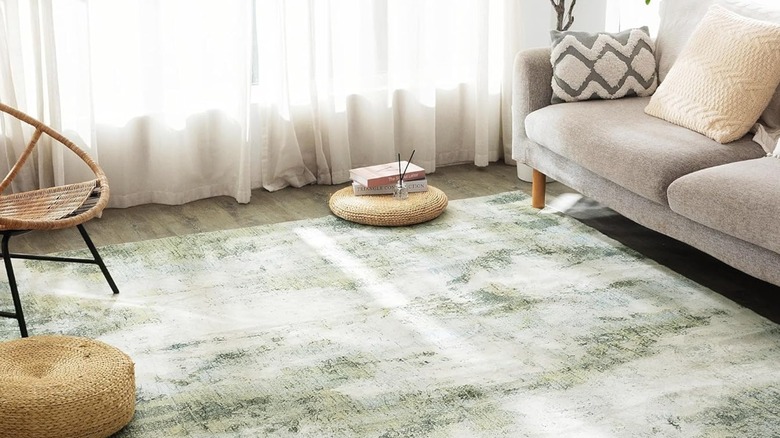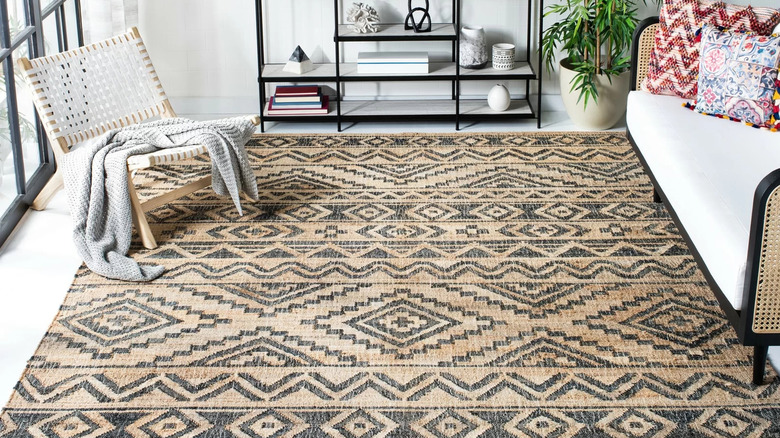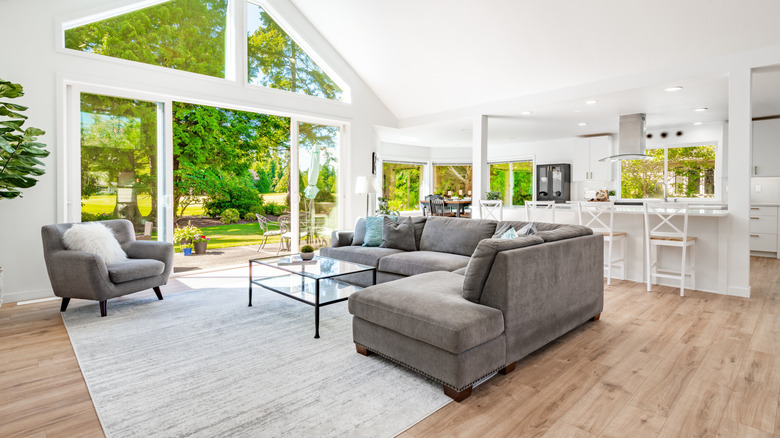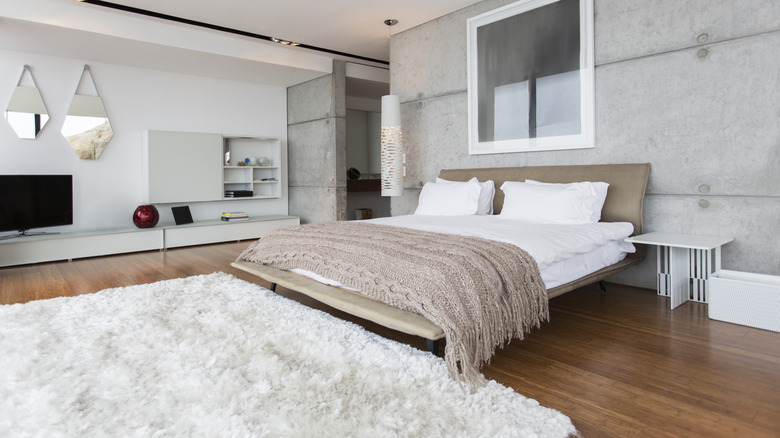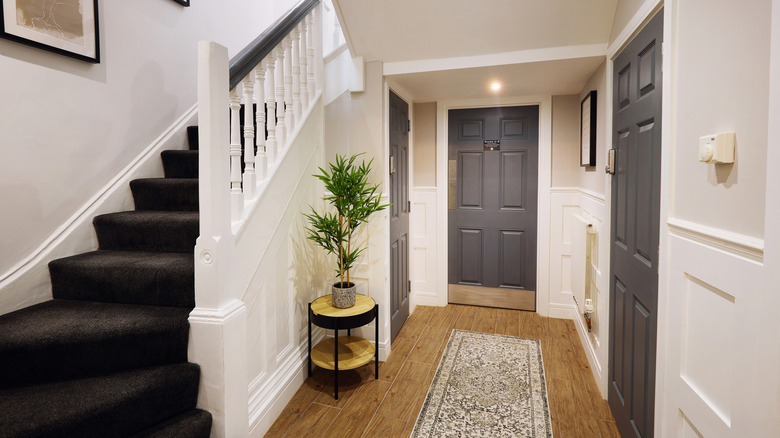8 Carpet Floor Trends That Are Having A Moment In 2025
We may receive a commission on purchases made from links.
If you're looking for new carpeting for your home, there are several factors you need to weigh. Not only should you consider the carpet color that you prefer, but you must also choose the right material for high-traffic areas and account for whether you have pets, which could impact how easy the material is to clean. However, there's one more factor that you'll want to give some thought to before finalizing the decision: trendiness. If you strive to keep up with the latest design trends, consider whether your carpet of choice aligns with what's popular at the moment — or whether it makes your space look outdated and boring.
When seeking information about carpeting trends, there's no better place to start than with the opinion of a seasoned interior designer. These professionals spend their days talking to clients, updating homes, and following the latest and greatest styles. For this reason, we reached out to several professional designers, who helped us put this piece together. Each of them spoke exclusively with House Digest, revealing a number of intriguing trends emerging in 2025. These include a renewed interest in wall-to-wall carpeting, a growing desire for earthy tones and eco-friendly materials, some interesting new preferences for texture and pile height, and more.
Wall-to-wall carpeting is seeing a bit of a comeback
It's likely that you had wall-to-wall carpeting in the home where you grew up. Between the 1950s and the 1980s, it was highly popular and installed in many living rooms, bedrooms, basements, and even some bathrooms and kitchens. With time, it started to become less and less sought after, making way for the surge of laminate, engineered hardwood, and other materials. However, design trends are shifting again, and according to Kelly Kuehn, an interior designer at FLOOR360, this once-dated flooring trend is making a return in 2025.
"With the rise of Modern Traditional design style that relies on mixing vintage and new design styles to create comfortable spaces, it was inevitable that homeowners would turn to wall-to-wall carpeting again," says Kuehn when speaking exclusively to House Digest. She points out several benefits of carpeting that are helping to bring about its revival, including its comfort, the warmth it can add to a room, and its ability to absorb sounds. "Wall-to-wall carpeting helps set a design tone that's nostalgic and comfortable with a tactile textured flooring surface," Kuehn shares.
Textured carpets are gaining popularity because of their practicality and looks
If you want to elevate your living space, opting for a textured carpet might just be the way to go. In her exclusive interview with House Digest, Bertha Sanchez, interior designer and owner of Floor Coverings International of Southwest Denver, Colorado, says, "Textured carpets, especially those with subtle variations like ribbed, looped, or cut-loop patterns, are dominating the market. Homeowners are craving floors that feel tactile and authentic, mirroring the larger trend toward biophilic design and nature-inspired interiors." Beyond the authentic feel these rugs add to a space, Sanchez also highlights their practicality. She says that their textured design can help hide some of the wear and tear that is so blatantly visible on other types of carpets.
So, why are textured carpets currently having such a moment of popularity these days? According to Sanchez, people are turning away from more minimalist designs and "leaning into cozier, layered looks that feel personal and grounded." If you're wondering whether this is the right look for your space — or are hesitant to pay for all new carpeting at the moment — you might want to consider starting with a textured area rug. Options such as the Beverly Fluffy Area Rug or nuLoom Plush Area Rug really deliver that natural look with their ribbed design, but they are available for a fraction of what you'd spend to carpet an entire room. Consider the benefits of adding one of these designs to your home. "Textured carpet provides visual warmth and a sensory experience underfoot, perfect for creating a sense of calm at home," Sanchez says.
You'll see more and more earth-toned carpets
Carpet trends come and go, but certain aesthetic elements, such as neutral tones, are timeless. However, according to Sanchez, "... the neutrals of 2025 are deeper and more nature-inspired — think clay, sage green, warm taupe, sand, and mushroom gray." Sanchez explains why these earthier and more muted colors seem to be having their moment of fame right now. She says, "As sustainability and wellness continue to influence home design, earthy colors help create a more restorative environment." Moreover, according to Sanchez, earthier colors add more complexity and a sense of grounding than the neutral beiges and grays that have been previously popular.
If you want to pull the whole design together, consider painting your walls in an earthy tone that coordinates with the carpeting you choose. For example, if you opt for sage green or mushroom gray rugs, you might want to pair them with sand or warm taupe paint (such as the PRESTIGE Elements Soft Cashmere Paint and Primer in One) for the wall.
Patterned carpeting is being used as a key element of room design
Until recently, you'd likely only find heavily patterned carpeting in old homes or in a design magazine highlighting trends that have come and gone. However, according to Sanchez, there are some patterned carpet trends that you'll be seeing more of in 2025. "Boldly patterned carpeting, from classic geometrics to more abstract, artistic designs is making a strong comeback, especially in bedrooms, home offices, and boutique-style living rooms. Designers are using carpeting not just for comfort but as a major design statement," she says.
There are a few reasons Sanchez cites to explain why bold-patterned wall-to-wall carpets are seeing such a recent increase in popularity. She explains how today's styles are cleaner, crisper, and simpler to care for than designs of the past. Moreover, Sanchez shares, "People are personalizing their homes more than ever, and patterned carpets allow homeowners to express individuality without overwhelming a space." This is another trend that you can take for a bit of a test drive by starting with a boldly patterned geometric area rug, such as the Lahome Modern Rainbow Jute Area Rug or the nuLOOM Maris Color Geometric Tiles Area Rug.
Many consumers are seeking more sustainable carpeting materials
While an interest in sustainability and eco-friendly materials has been on the rise in recent years, Sanchez notes that it's becoming even more prominent in the design world. "Sustainability is no longer a luxury preference; it's becoming an expectation. People are making more thoughtful purchasing decisions, seeking products that are healthier for their families and the planet." Because of this change in consumer opinions and priorities, Sanchez explains, "Eco-friendly and performance-driven carpets, made from recycled fibers, natural wool, or innovative materials that resist stains and moisture — are highly in demand." Beyond natural wool, some other sustainable materials used to make rugs include jute, organic cotton, and even recycled plastic water bottles.
With friendly materials and production processes, such carpets are appealing. As Sanchez explains, today's homeowners are more aware of how the design choices they make impact not only their living space but also the planet as a whole. If you've been looking for the best ways to design your home with sustainable materials, eco-friendly carpeting is a great place to start. Think about how much of the floor area you'll be covering with the eco-friendly carpet fabric, and you should be able to visualize just how impactful this choice of material could be.
Very low-pile carpets are gaining traction
If you've been wandering through carpet or home improvement stores to browse through different types of carpet for your home, you may have noticed the drastic difference between low- and high-pile options. Pile refers to the height of the carpet fibers. While high-pile options have a length of at least a ½ inch (with many being even longer), low pile carpet height doesn't exceed a ¼ inch. According to Evelina Juzėnaitė, principal interior designer at Planner 5D, there are several reasons you should consider adding a low-pile carpet to your home if you want to keep up with the design trends of 2025.
Speaking exclusively with House Digest about low-pile carpets, Juzėnaitė shares, "They are popular because they are considered versatile and look modern and aesthetic. Their easy cleaning and durability align perfectly with the modern desire for efficiency, saving both time and money." With the ease of cleaning and fewer areas for bacteria and allergens to hide, they're also one of the best types of carpet to install in your basement.
High-pile carpeting is also having a moment
Don't let low-pile carpets' current trendiness make you think that high-pile carpets are out of style. While some appreciate the more minimalist look of short fibers, others are drawn to the lusher and more lavish look of high-pile carpeting.
Sabrina Phillips, contractor, interior designer, and owner of the successful firm Designing Women of Orange County, exclusively tells House Digest why she's seeing more clients opt for high-pile carpeting these days. "It's that type of carpet that is ultra-soft, with luxurious textures, and especially used in bedrooms and lounges. I'd say [that] after years of minimalism, people are craving comfort and tactile coziness at home," she says. Consider trying an area rug to see if this plush and cozy carpet trend is right for you. The Zentavio Plush Area Rug and the Litanika Shag Area Rug are two attractive options that both come in a wide assortment of colors and patterns.
Carpeted staircases are staging a comeback in 2025
It wasn't that long ago that a carpeted staircase would not have been a home's selling point. With modern and minimalist designs, leaving hardwood on the steps exposed would have been much more appealing. However, what's old is new again, and Jason Nazmiyal, owner and interior design expert at Nazmiyal Collection, says that carpeted staircases are making a comeback. "As maximalism makes its way back to interior aesthetics, homeowners are now playing with colors, especially in deep, saturated shades like blue or rust orange, in the staircase — an often-neglected focal point," he shares in his exclusive interview with House Digest.
Beyond the way carpeting over a staircase can enhance a room's design, Nazmiyal also notes that it can deliver additional benefits to the home. First, carpets are much warmer and cozier than hard floors — both literally and figuratively. So, not only will your feet stay warmer as you walk up or down the stairs, but your home will also have a more welcoming feel. Carpeted stairs are also safer than those made from hardwood. They'll provide more of a cushion if a young child or any other member of the house trips when walking up or down.
